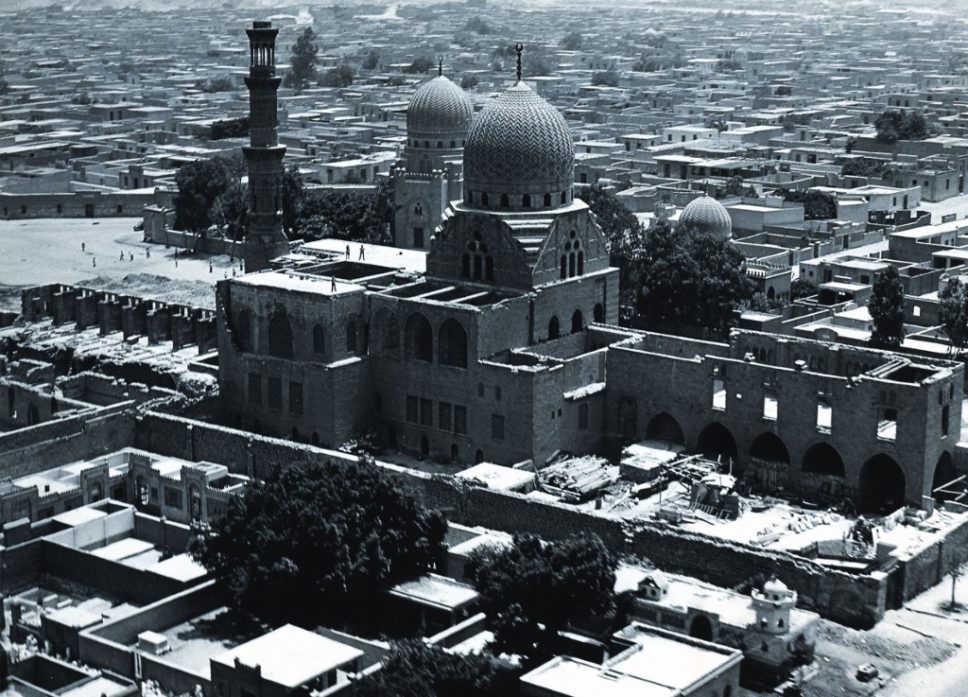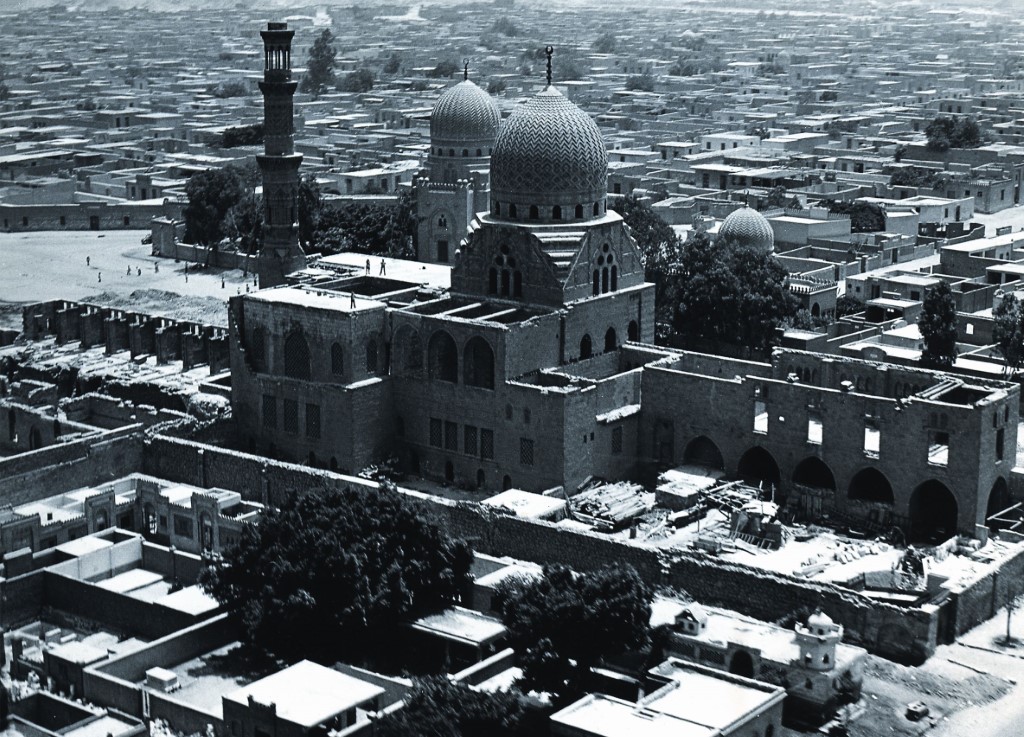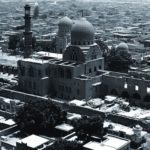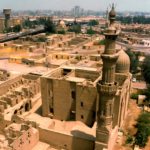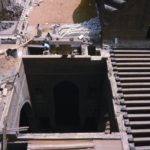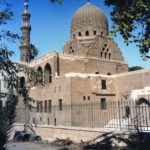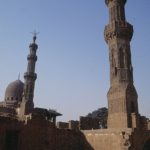Cairo, complex of Emir Qurqumas
Funerary complex of Emir Qurqumas (Emir Kebir Qurqumas)
-
Project name:
Polish-Egyptian Mission for the Restoration of Islamic Monuments in Cairo
(City of the Dead, Mausoleum of Emir Kabir Qurqumas/Mosque of Amir Qurqumas)
-
Type of site:
Mosque, funerary complex
Location:
Egypt
Cairo (northern part of the “Northern Necropolis”)Dating:
Mamluk period (complex built in the first decade of the 16th century)
Most interesting finds:
– Madrasah-type mosque
– Temporary residence of the founder – qasr
– Sufi meetinghouse – khanqah
– Multicolored marble facings of walls and floors
– Polychromed wood ceilings
– Quranic inscriptions carved in low relief
History of research:
Dates of PCMA mission’s work:
1972–2000
Type of research:
Archaeological and conservation works
Directors:
– Andrzej Misiorowski (1972–1974)
– Ireneusz Nieduziak (1974–1977)
– Jerzy Kania (1977–1989; 1995–2000)
– Andrzej Żaboklicki (1990–1991)
– Jarosław Dobrowolski (1992–1995)
Co-operating institutions:
– Polish Centre of Mediterranean Archaeology, University of Warsaw
– Institute of Mediterranean and Oriental Cultures, Polish Academy of Sciences (then Research Center for Mediterranean Archaeology PAS – ZAŚ PAN)
– State Ateliers for Conservation of Cultural Property (PP PKZ)
– Egyptian Antiquities Service
Additional information:
In 1972, the Polish-Egyptian Group for the Restoration of Islamic Monuments was created. It included Andrzej Misiorowski, Ireneusz Nieduziak, Jerzy Kania (PP PKZ), Jarosław Dobrowolski (PCMA UW), and Maciej Witkowski (ZAŚ PAN).
Description of the site and research:
According to the inscription above the entrance, the monumental complex of emir Qurqumas was founded in 1507. It consists of a mosque/madrasah (Quranic school), a Sufi meetinghouse, the emir’s residence, and the neighboring funerary complex of sultan Ashraf Inal. It is an example of Mamluk architecture in its most developed form. The complex was abandoned in the 18th century.
The work on the site included archaeological excavations of grave chambers and foundations, anthropological research, architectural and conservation works, as well as historical studies, for example of the 16th-century donation deed of emir Qurqumas (hogga).
Research results:
Season by season – “PCMA Newsletter”:
Jubilee publication: 70 Years of Polish Archaeology in Egypt
Witkowski, M. G. (2011). Burials in the complex of Great Amir Qurqumas (No. 162) in Cairo’s „Northern Necropolis”. Polish Archaeology in the Mediterranean 20, 587-603.
Witkowski, M. G. (2007). Amir Qurqumas Complex in Cairo. In E. Laskowska-Kusztal (ed.), Seventy Years of Polish Archaeology in Egypt, Polish Centre of Mediterranean Archaeology (pp. 191–204), University of Warsaw.
Witkowski, M. (2001). The Izara Friezes in the Sidlasof the Great Amir Qurqumas’ Madrasaat Cairo North Cemetery (No. 162). Some Notes on a Margin of an Epigraphic Survey (1998–1999), Études et Travau XXIX, 337–353
Kania, J. J. (2000). Cairo: Funerary complex of Amir Kebir Ququmas, 1999. Polish Archaeology in the Mediterranean 11, 83-88.
Kania, J. J. (1999). Cairo: Funerary complex of Amir Kebir Ququmas, 1998. Polish Archaeology in the Mediterranean 10, 77-80.
Kania, J. J. (1998). Cairo: Funerary complex of Amir Kebir Ququmas. Polish Archaeology in the Mediterranean 9, 37-42.
Kania, J. J. (1997). Cairo: Funerary complex of Amir Kebir Ququmas. Polish Archaeology in the Mediterranean 8, 40-45.
Dobrowolski, J. (1996). Cairo: Funerary complex of Amir Kebir Ququmas form January 1 to April 31, 1995. Polish Archaeology in the Mediterranean 7, 23-28.
Witkowski, M. G. (1996). Cairo: Funerary complex of Amir Kebir Ququmas form May 31 1 to December 31, 1995. Polish Archaeology in the Mediterranean 7, 29-39.
Dobrowolski, J. (1995). Zespół grobowy emira Qurqumasa w Kairze. In M. L. Bernhard (ed.), Od Nilu do Eufratu. Polska Archeologia Śródziemnomorska 1981–1994 (pp. 61-68), Warszawa: PCMA
Dobrowolski, J. (1995). Cairo 1993/4, Polish-Egyptian Mission for Islamic Architecture, Amir Kebir Qurqumas Project. Polish Archaeology in the Mediterranean 6, 21-27.
Dobrowolski, J. (1994). Polish-Egyptian mission for Islamic architecture in Cairo: Amir Kebir Qurqumas Project season 1992-93. Polish Archaeology in the Mediterranean 5, 48-51.
Scholl, T. and El-Menabbawy, M. (1994). Amir Kebir Qurqumas Mausoleum in Cairo: 1993. Polish Archaeology in the Mediterranean 5, 52-54.
Scholl, T. and El-Menabbawy, M. (1993). Emir Qurqumas in Cairo: Excavations in the southern yard, 1992. Polish Archaeology in the Mediterranean 4, 40-42.
Kania, J. J. (1986). Zespół grobowy emira Qurqumasa w Kairze. In Z. Kiss (ed.), 50 lat polskich wykopalisk w Egipcie i na Bliskim Wschodzie (pp. 101-106), Warszawa
Misiorowski, A. (1979). Mausoleum of Qurqumas in Cairo: an example of the architecture and building art of Mamlouk Period, Warszawa
Praca zbiorowa. (1985). Mausoleum of Qurqumas in Cairo. Results of Investigations and Conservation Works 2, Warszawa: Wydawnictwa Pracowni Konserwacji Zabytków
Gallery:
-
1. View of the Qurqumas complex / Widok na kompleks Qurqumasa (fot. Archiwum CAŚ UW)
-
2. View of the Qurqumas complex / Widok na kompleks Qurqumasa (fot. Archiwum CAŚ UW)
-
3. The Mosque of Qurqumas – reconstruction of the ceilings / Meczet Qurqumasa – rekonstrukcja stropów (fot. Archiwum CAŚ UW)
-
5. The Mosque of Qurqumas after reconstruction / Meczet Qurqumasa po odbudowie (fot. Archiwum CAŚ UW)
-
4. Minarets of the Mosque of Qurqumas / Minarety meczetu Qurqumasa (fot. Archiwum CAŚ UW)

